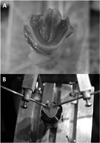Use of the rabbit larynx in an excised larynx setup
- PMID: 23159025
- PMCID: PMC3538959
- DOI: 10.1016/j.jvoice.2012.08.004
Use of the rabbit larynx in an excised larynx setup
Abstract
Objective: To modify the excised larynx bench apparatus to accommodate experiments with rabbit larynges.
Study design: Methodological study using ex vivo rabbit larynges.
Methods: Rabbit larynges (n=5) were dissected and mounted on a custom-made phonatory apparatus. The arytenoids were adducted by rods, and humidified air was passed through the larynx to elicit vocal fold vibration. Acoustic, aerodynamic, electroglottographic (EGG), and videokymographic data were collected for each larynx. The same data were collected for five canine larynges for the purpose of comparison, and coefficients of variation were calculated for each parameter in both models.
Results: Reliable phonation was achieved in each larynx. Acoustic fundamental frequency (F(0)), percent jitter, percent shimmer, signal-to-noise ratio, pressure and flow at phonation onset and offset; and F(0), closed quotient, speed quotient, jitter, shimmer, and contact quotient, as recorded by EGG; and mucosal wave amplitude and phase difference are reported for rabbit larynges. Coefficients of variation for each parameter are similar in magnitude between the two models.
Conclusion: We developed a method for recording reliable acoustic, aerodynamic, videokymographic, and EGG data from rabbit larynges. When data obtained from leporine larynges were compared with data from canine larynges, the intralarynx variability of rabbit larynges was found to be similar to that of canine larynges.
Copyright © 2013 The Voice Foundation. Published by Mosby, Inc. All rights reserved.
Conflict of interest statement
Conflicts of Interest: None
Figures



References
-
- Cooper DS. Research in laryngeal physiology with excised larynges. In: Cummings CW, editor. Otolaryngology—Head and Neck Surgery. 3rd ed. St. Louis: C.V. Mosby; 1986. pp. 1766–1776.
-
- Baer T. Unpublished Ph.D. dissertation. Cambridge, MA: Massachusetts Institute of Technology; 1975. Investigation of phonation using excised larynxes; pp. 137–170.
-
- Durham PL, Scherer RC, Titze IR, Druker DG. Development of excised larynx procedures for studying mechanisms of phonation. Technical Report VABL-1. 1987
-
- Garrett CG, Coleman JR, Reinisch L. Comparative histology and vibration of the vocal folds: implications for experimental studies in microlaryngeal surgery. Laryngoscope. 2000;110(5):814–824. - PubMed
Publication types
MeSH terms
Grants and funding
LinkOut - more resources
Full Text Sources
Other Literature Sources

